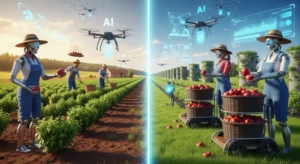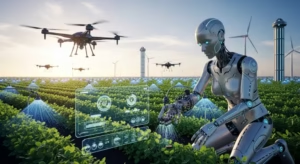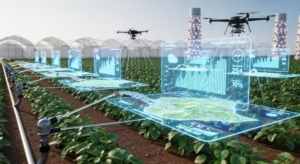AI in Agriculture: The Next Revolution in Food Production

The blog post titled AI in Agriculture: The Next Revolution in Food Production delves into the transformative effects of AI in agriculture. It begins by exploring how AI technologies enhance farming efficiency and productivity. The article discusses precision farming techniques, including data analytics and machine learning, which allow farmers to make informed decisions for optimal crop yields. Additionally, it highlights practical applications such as smart irrigation systems and crop prediction models that utilize AI to conserve resources and improve harvest forecasting. Finally, the post summarizes key takeaways and outlines next steps for integrating AI in Agri-Tech, emphasizing its potential to revolutionize food production, ensure sustainability, and boost food security. Overall, this insightful piece serves as a comprehensive guide for stakeholders interested in the future of AI in agriculture.
Understanding The Impact Of AI In Agriculture

The integration of AI in agriculture represents a significant paradigm shift in food production and farming techniques. With the increasing global demand for food, AI technologies are paving the way for enhanced efficiency and sustainability. By analyzing vast amounts of data, these innovative solutions help farmers make informed decisions that optimize crop yields and reduce resource wastage. As farming practices evolve, the focus on precision farming ensures that every aspect of cultivation is meticulously managed, from soil health to pest control, ultimately fostering a more resilient agricultural system.
Key Areas Where AI Influences Agriculture
- Soil Health Monitoring
- Pest and Disease Detection
- Crop Yield Prediction
- Automated Irrigation Systems
- Data-Driven Decision Making
- Optimal Resource Allocation
- Supply Chain Optimization
Furthermore, the role of AI in agriculture extends beyond mere automation; it empowers farmers to adopt sustainable practices that are crucial in combating climate change. By employing precision farming techniques, these technologies facilitate targeted interventions, minimizing environmental impacts while maximizing productivity. As a result, AI-driven solutions not only enhance profitability but also support the broader goal of sustainable development in the agricultural sector.
Diving Into Precision Farming Techniques And Technologies

Precision farming is revolutionizing the agricultural landscape by integrating advanced technologies and innovative techniques. Central to this transformation is the implementation of AI in agriculture, which enhances productivity and efficiency across various farming practices. By leveraging data analytics, sensors, and automation, farmers can make informed decisions that resonate with sustainable agriculture. This approach emphasizes the importance of utilizing resources wisely, which aligns with the growing demand for food in a world facing climatic challenges.
Utilizing tools like drones, satellite imagery, and IoT devices, precision farming enables precise monitoring of crop conditions, soil quality, and overall farm management. These technologies work hand-in-hand with smart irrigation systems, allowing farmers to optimize water usage and minimize wastage. Together, they represent a significant leap toward sustainable farming practices. The global agri-tech landscape is witnessing rapid innovation, offering solutions that seamlessly integrate into existing farming frameworks.
| Technology | Purpose | Benefits |
|---|---|---|
| Drones | Crop monitoring and mapping | Improved yield analysis |
| IoT Sensors | Data collection on soil and crop health | Real-time insights for better decisions |
| Smart Irrigation | Automating water distribution | Conservation of water resources |
| Machine Learning | Predictive analytics for crop yield | Enhanced forecasting of farming outcomes |
Understanding how to implement precision farming is crucial for farmers aiming to harness its full potential. The adoption of these cutting-edge technologies is often viewed with skepticism; however, the benefits far outweigh initial challenges. By embracing AI-driven tools and methodologies, farmers can significantly enhance productivity while adhering to the principles of environmental stewardship.
Steps To Implement Precision Farming
- Assess current farming methods and identify areas for improvement.
- Research available precision farming technologies and their applications.
- Invest in smart irrigation systems to enhance water management.
- Utilize drones and IoT sensors for precise monitoring.
- Analyze data collected for informed decision-making.
- Iterate processes based on feedback and analytics.
- Stay updated with new developments in agri-tech solutions.
Technologies Used In Precision Farming
The core of precision farming lies in its varied technologies, each offering unique benefits to farmers. Employing AI in agriculture is manifested through the integration of machine learning algorithms, which analyze vast data sets to predict outcomes and optimize farming practices. From smart irrigation that conserves water to crop management systems that track growth patterns in real-time, these technologies create a more sustainable and efficient farming future.
Benefits Of Precision Farming
The advantages of precision farming extend beyond immediate productivity gains. By adopting these innovative techniques, farmers can significantly reduce resource wastage, leading to lower operational costs and higher profitability. Moreover, the environmental impact of agriculture is minimized as practices become more sustainable and less resource-intensive. Ultimately, precision farming represents a paradigm shift in how agricultural practices align with modern technological advancements, catering to the increasing need for efficiency in food production.
Practical Applications Of Smart Irrigation And Crop Prediction

As the demand for sustainable food production rises, AI in agriculture plays a crucial role in enhancing efficiency and optimizing resources. Smart irrigation systems and crop prediction technologies are integral components of modern agri-tech, enabling farmers to make data-driven decisions. These advanced solutions not only improve crop yields but also lead to significant water conservation. With climate change and its impacts on farming, these technologies provide a pathway to sustainable agricultural practices.
Benefits Of Smart Irrigation
- Efficient water use, reducing waste.
- Improved crop health and yield.
- Data-driven insights for better decision-making.
- Cost savings in water and energy consumption.
- Integration with IoT devices for real-time monitoring.
- Adaptability to varying weather conditions.
Implementing advanced irrigation techniques allows farmers to use the least amount of water necessary while maximizing crop production. Furthermore, resource management becomes more manageable, as farmers can track moisture levels and adjust irrigation schedules accordingly. Adopting crop prediction models ensures that farmers can anticipate yields and plan their planting strategies effectively, aligning with market demands.
Real-Life Examples Of Crop Prediction
Crop prediction technologies leverage AI and machine learning algorithms to analyze vast datasets, resulting in remarkably accurate forecasts. For instance, companies such as Descartes Labs employ satellite imagery and meteorological data to provide insights into crop health and yield expectations. These innovations empower farmers to make informed decisions regarding resource allocation and harvesting timelines.
“By integrating AI-driven crop prediction models, farmers not only increase their profits but also contribute to a more sustainable future.”
Key Takeaways And Next Steps In AI for Agri-Tech

As we embrace the advancements of AI in agriculture, it is crucial for farmers and stakeholders to understand the transformative potential of these technologies. From enhancing productivity to ensuring sustainable farming practices, the integration of AI offers a plethora of opportunities to revolutionize food production. By leveraging data-driven decisions, farmers can optimize crop yields and reduce waste, ultimately leading to a more efficient agricultural ecosystem.
Actionable Steps For Farmers
- 1. Invest in AI-driven tools for data analysis and crop management.
- 2. Incorporate precision farming techniques to monitor crop health.
- 3. Utilize smart irrigation systems for optimized water usage.
- 4. Attend workshops or training sessions on AI applications in agriculture.
- 5. Collaborate with tech companies to stay updated on innovations.
- 6. Implement machine learning models for predictive analytics.
- 7. Evaluate and adopt sustainable farming practices alongside AI tools.
To maximize the benefits of these technologies, it is imperative for agribusinesses to remain agile and willing to adapt. Embracing precision farming allows for customized approaches to agriculture, tailoring strategies based on soil health, weather patterns, and crop conditions. This proactive stance not only boosts productivity but also enhances environmental stewardship, aligning modern farming with sustainable practices.
Briefing Document: AI in Agriculture – The Next Revolution
I. Executive Summary
This briefing document reviews the transformative impact of Artificial Intelligence (AI) on the agricultural sector, highlighting its potential to enhance efficiency, productivity, and sustainability in food production. The core theme across the provided sources is the integration of AI-driven “precision farming” techniques, which leverage data analytics, machine learning, and automation to optimize various aspects of cultivation. Key applications include smart irrigation, crop prediction, soil health monitoring, and pest/disease detection. The overarching goal is to meet increasing global food demands while minimizing environmental impact and fostering a more resilient agricultural system.
II. Main Themes and Most Important Ideas/Facts
A. AI as a Paradigm Shift in Agriculture
The integration of AI represents a “significant paradigm shift in food production and farming techniques.” It is crucial for “enhanced efficiency and sustainability” in the face of “increasing global demand for food.” By analyzing “vast amounts of data,” AI solutions empower farmers to make “informed decisions that optimize crop yields and reduce resource wastage.”
B. Precision Farming: The Core Application of AI
Precision farming is consistently highlighted as the central concept. It involves “integrating advanced technologies and innovative techniques” to meticulously manage every aspect of cultivation.
- Definition: Precision farming “enhances productivity and efficiency across various farming practices” by “leveraging data analytics, sensors, and automation.”
- Key Technologies:Drones: Used for “crop monitoring and mapping,” leading to “improved yield analysis.”
- IoT Sensors: Enable “data collection on soil and crop health,” providing “real-time insights for better decisions.”
- Machine Learning Algorithms: Analyze “vast data sets to predict outcomes and optimize farming practices,” crucial for “predictive analytics for crop yield” and “enhanced forecasting of farming outcomes.”
- Satellite Imagery: Used by companies like Descartes Labs for “insights into crop health and yield expectations.”
- Benefits:Resource Optimization: “Utilizing resources wisely,” particularly water, by allowing farmers to “optimize water usage and minimize wastage.”
- Reduced Waste & Costs: “Significantly reduce resource wastage, leading to lower operational costs and higher profitability.”
- Environmental Stewardship: Minimizes “environmental impact of agriculture as practices become more sustainable and less resource-intensive.” This includes “combating climate change” through “targeted interventions.”
- Improved Decision-Making: Provides “data-driven insights for better decision-making.”
C. Practical Applications: Smart Irrigation and Crop Prediction
These two applications are presented as integral components of modern agri-tech, directly addressing resource efficiency and yield management.
- Smart Irrigation:
- Purpose: Automates “water distribution” based on real-time data, allowing farmers to “use the least amount of water necessary while maximizing crop production.”
- Benefits: “Efficient water use, reducing waste,” “improved crop health and yield,” and “cost savings in water and energy consumption.” It also offers “adaptability to varying weather conditions.”
- Mechanism: Integrates with “IoT devices for real-time monitoring” of “moisture levels.”
- Crop Prediction:
- Purpose: Leverages “AI and machine learning algorithms to analyze vast datasets, resulting in remarkably accurate forecasts.”
- Benefits: Empowers farmers to “anticipate yields and plan their planting strategies effectively, aligning with market demands,” and make “informed decisions regarding resource allocation and harvesting timelines.”
- Quote: “By integrating AI-driven crop prediction models, farmers not only increase their profits but also contribute to a more sustainable future.”
D. Sustainability and Food Security
A recurring theme is AI’s role in supporting broader societal goals beyond immediate farm profitability.
- Sustainability: AI “empowers farmers to adopt sustainable practices that are crucial in combating climate change.” Precision farming “minimizing environmental impacts while maximizing productivity.”
- Food Security: AI’s potential to “boost food security” is explicitly mentioned, ensuring sufficient food production for a growing global population.
III. Key Takeaways and Recommended Next Steps for Stakeholders
The sources emphasize the necessity for farmers and agribusinesses to embrace AI for future success.
A. Key Takeaways
- AI is not merely automation but a tool that “empowers farmers” with data-driven insights.
- The benefits of AI in agriculture “far outweigh initial challenges” associated with adoption.
- AI-driven solutions enhance both profitability and environmental responsibility.
- Agribusinesses must “remain agile and willing to adapt” to maximize benefits.
B. Actionable Steps for Farmers/Stakeholders
- Investment: “Invest in AI-driven tools for data analysis and crop management.” This includes “smart irrigation systems” and technologies for “precise monitoring” like drones and IoT sensors.
- Implementation: “Incorporate precision farming techniques” and “implement machine learning models for predictive analytics.”
- Education & Collaboration: “Attend workshops or training sessions on AI applications in agriculture” and “collaborate with tech companies to stay updated on innovations.”
- Strategic Integration: “Evaluate and adopt sustainable farming practices alongside AI tools,” tailoring strategies “based on soil health, weather patterns, and crop conditions.”
AI is poised to revolutionize agriculture, transitioning traditional farming into a highly efficient, data-driven, and sustainable industry. The adoption of precision farming techniques, enabled by AI, is critical for optimizing resource use, increasing yields, reducing environmental impact, and ultimately ensuring global food security. Stakeholders are encouraged to proactively invest in and integrate these transformative technologies.
Homepage / humanaifuture.com
For similar articles, please visit: / AI in Environment & Sustainability
🎧 Listen to the Podcast
Want to explore this topic in more depth? Listen to the full podcast for more insights and expert commentary.
▶️ Play on Google DriveNo sign-up needed — just click and listen.
How does precision farming utilize AI to revolutionize agriculture?
Precision farming revolutionizes agriculture by integrating AI with advanced technologies like drones, satellite imagery, and IoT devices. This allows for precise monitoring of crop conditions, soil quality, and overall farm management. AI, through machine learning algorithms, analyzes vast datasets to predict outcomes and optimize practices, leading to more sustainable and efficient farming by enabling targeted interventions, optimized resource allocation, and real-time insights for better decision-making.
What are some key areas where AI specifically influences agricultural practices?
AI influences agricultural practices in several key areas, including:
- Soil Health Monitoring: Analyzing data to understand and improve soil conditions.
- Pest and Disease Detection: Early identification to prevent widespread damage.
- Crop Yield Prediction: Forecasting harvests for better planning and resource allocation.
- Automated Irrigation Systems: Optimizing water usage through smart technologies.
- Data-Driven Decision Making: Empowering farmers with insights for informed choices.
- Optimal Resource Allocation: Ensuring efficient use of water, fertilizers, and other resources.
- Supply Chain Optimization: Improving the efficiency of the entire food production and distribution process.
How do smart irrigation systems and crop prediction models contribute to sustainable agriculture?
Smart irrigation systems and crop prediction models are integral to sustainable agriculture. Smart irrigation utilizes AI and IoT devices to optimize water usage, reducing waste and improving crop health, leading to significant water conservation and cost savings. Crop prediction technologies, leveraging AI and machine learning, analyze vast datasets (like satellite imagery and meteorological data) to forecast yields accurately, enabling farmers to plan planting strategies effectively and align with market demands, thus promoting efficient resource management and a more sustainable future.
What specific technologies are at the core of precision farming?
The core of precision farming lies in the integration of various technologies, with AI being central. These include:
- Drones: Used for crop monitoring and mapping, providing improved yield analysis.
- IoT Sensors: Collect real-time data on soil and crop health, offering crucial insights for decisions.
- Smart Irrigation Systems: Automate water distribution for optimal water conservation.
- Machine Learning Algorithms: Power predictive analytics for crop yield and optimize farming practices based on vast datasets.
These technologies work together to create a more sustainable and efficient farming future.
What are the main benefits of adopting precision farming techniques for farmers?
The main benefits of adopting precision farming techniques for farmers extend beyond immediate productivity gains. Farmers can significantly reduce resource wastage (such as water and fertilizers), leading to lower operational costs and higher profitability. Furthermore, the environmental impact of agriculture is minimized as practices become more sustainable and less resource-intensive, aligning modern farming with technological advancements and the increasing need for efficiency in food production.
What actionable steps can farmers take to integrate AI into their agricultural practices?
To integrate AI into their agricultural practices, farmers can take several actionable steps:
- Invest in AI-driven tools for data analysis and crop management.
- Incorporate precision farming techniques to monitor crop health precisely.
- Utilize smart irrigation systems for optimized water usage.
- Attend workshops or training sessions to learn about AI applications in agriculture.
- Collaborate with tech companies to stay updated on innovations.
- Implement machine learning models for predictive analytics.
- Evaluate and adopt sustainable farming practices alongside AI tools.




